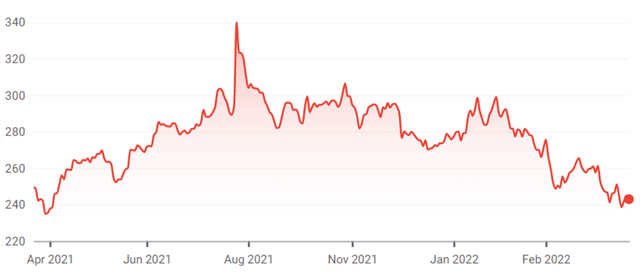martinrlee/iStock Editorial via Getty Images
U.K. supermarket chain Sainsbury (OTCQX:JSAIY) continues to plod along and its shares have drifted lower. I do continue to see future growth prospects here, but for now, still regard the shares as somewhat overpriced so maintain a “sell” rating.
Challenging but Potentially Strong Outlook for U.K. Retailers
Rival Tesco’s recent quarterly results were an interesting insight into the dynamics facing large U.K. retailers such as Sainsbury. On one hand, sizeable risks continue to haunt the sector, especially the relentless rise of continental discounters such as Aldi and Lidl and the potential belt-tightening expected from British consumers in the face of the soaring cost of living.
On the other hand, sales were up even compared to pre-pandemic and gross profit rose by over 50%. Inflation is a challenge but shoppers are braced for hefty price increases so it may be that large retailers can pass on cost increases and maintain profit margins. A worsening economic outlook and mounting cost of living concerns could be good for Sainsburys and its peers as it may shift some out-of-home dining back to at-home, pushing up sales.
Its own most recent trading statement, in January, projected underlying pre-tax profit of at least £720m for its full year. That would be 102% higher than the previous year, though at the earnings level I expect the difference may be less dramatic. Still, £720m is well ahead of consensus forecasts and 23% up on the 2020 figures which only included a few weeks of pandemic impact.
Unexciting Investment Case at Current Price
Although the yield of over 4% is attractive to me, the dividend has grown only 4% in total over five years (Tesco recently announced a 19% increase, albeit its dividend remains below where it was prior to its 2014 accounting scandal). The yield is attractive but growth prospects are not that exciting and if I was looking at this from an income perspective, I think there are better candidates in the U.K. stock market.
As to growth, I continue to like the digital commerce story at Sainsbury. But in the third quarter, general merchandise and clothing sales fell both against the prior year and two-year prior period. Online groceries boomed, but that part of the digital commerce story is not more (or less) exciting than, say, Tesco. It is in the Argos brand that I see the strongest digital commerce story for Sainsbury and at the moment the growth is inconsistent. Is there a growth story at Sainsburys? I think there is. But while revenues have been growing in recent years, profits have been shrinking. So, again, I see more compelling growth cases in other shares.
Perennial Prospects as a Merger Candidate
Over the past couple of years, two of the U.K.’s four leading supermarket chains – Asda and Morrisons – have been sold, in the case of Morrisons that meant it was delisted from the stock market. Inevitably, some commentators, therefore, suggest that the U.K. supermarket sector looks undervalued and the remaining big players could be future takeover candidates.
I don’t disagree with that. Tesco’s market leadership means it may be more politically problematic to buy, so Sainsbury is the most obvious candidate. Its omnichannel focus could be attractive to a number of international groups. However, I’d see any future takeover approach as a bonus if one owns Sainsburys shares (depending on the price at which it is pitched – even at double the current share price some long-term shareholders would not recoup their purchase price) rather than a reason to buy them. Sainsburys has been the subject of takeover chatter for decades and it has come to naught, with the competition authority blocking a proposed tie-up with Asda in 2019.
Valuation Continues to Look Overdone
My last, bearish note on Sainsbury was Sainsbury: Looking Overvalued in August. Since then the share price has fallen 17%.
Sainsburys share price chart (Google Finance)
At the moment the company trades on a P/E ratio of 20 using adjusted earnings. But statutory basic earnings per share were negative last year. Even using the best of the past five years – 2017 – the current share price indicates a P/E ratio of 14 which is fine but does not scream value to me.
Meanwhile, the business continues to face challenges including intense competition and price inflation which mean that it is unlikely to get back to those 2017 earnings any time soon, in my view. So the prospective P/E ratio at best is likely in the high teens. That looks overpriced to me – highly successful rival Tesco is trading on a P/E of just 12 right now. Some support for the current share price could come from income hunters, given the 4.4% yield. When full year results are announced they may also improve sentiment given the strong expected uptick in gross profit. So I do not necessarily expect Sainsbury’s to fall sharply. But I could see it continue to drift lower. In any case, I reckon it is somewhat overvalued and for that reason retain my “sell” rating.


Be the first to comment